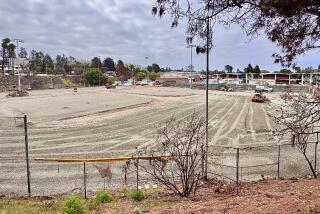Belmont: Faults, but Still Needed
- Share via
There are fault lines, and then there are fault lines.
And now that a real earthquake fault has been found under the Belmont Learning Complex, some city school board members may be tempted to pull the plug -- again -- on a project they never liked. That would be a mistake. Instead, they must find a safe way to finish the school, and soon. If not, they could set off new political tremors along the many social and economic fault lines of Los Angeles.
Conventional wisdom assumes that last week’s revelation of the earthquake faults by school district Supt. Roy Romer was the coup de grace for a project that has been controversial for years. It was killed by the board in 1999, only to be resurrected by Romer, with the passionate support of Latino political activists.
As before, the reasons are as much political as educational. Although Belmont has been on the school district’s drawing boards for a decade, a new school has been desperately needed in the densely populated and heavily immigrant neighborhoods west of downtown for at least 20 years. The old Belmont has 5,000 students crammed onto an aging campus originally designed for half that many. It was one of the first schools in the city to go on a year-round calendar because of overcrowding, yet hundreds of students are still bused every day, as far away as the San Fernando Valley.
After years of waiting, there are many frustrated parents -- not to mention angry students and impatient political activists -- in the Belmont neighborhood utterly convinced that a school would have been finished years ago, without this much controversy, if the student body were predominantly Anglo rather than mostly Latino.
And all the geological surveys and school-safety studies in the world will not overcome the suspicion many of those people now share that the sudden discovery of earthquake faults at the Belmont site is awfully convenient. It provides political cover for the paternalistic school reformers who control the Los Angeles Unified School District just three months before they stand for reelection. They get the chance to kill a controversial project they had criticized as a bureaucratic boondoggle in their last campaigns.
For the record, I do not share the cynical suspicions that the earthquake faults are being used as an excuse to kill Belmont once and for all. The preliminary findings of the geologists the LAUSD hired to study earthquake risks at the Belmont site are persuasive. There are many faults under the eastern side of the 45-acre school site, and one runs directly beneath two unfinished buildings. Under state laws that prohibit the construction of schools within 50 feet of known quake faults, those buildings must now be abandoned, at least for use as school facilities. But that does not mean giving up on the whole project, because the same geologic surveys found that 12 acres on the western side of the Belmont site are “unfaulted and unfractured.” They are also far enough away from known faults to allow for school construction.
That is where the LAUSD should start building a new Belmont High School, one smaller than the 3,500-student campus that was envisioned when ground was broken for the project in the early ‘90s.
To be sure, a smaller Belmont would not solve all of the school overcrowding problems in the neighborhood. There is still a need for new school sites in and around downtown. And board member Jose Huizar, in whose district Belmont sits, points out that it has been hard to find even five-acre sites. But at least finishing a Belmont High on the current site would be a gesture of good faith to a community that has been badly served by LAUSD decision makers for far too long.
Meanwhile, don’t look for members of the area’s Latino community to join in the panicky response to the discovery of earthquake faults, although they are deeply disappointed by this latest twist in the long Belmont saga. They know that reports of Belmont’s death have been greatly exaggerated before.
*
Frank del Olmo is associate editor of The Times.
More to Read
Sign up for Essential California
The most important California stories and recommendations in your inbox every morning.
You may occasionally receive promotional content from the Los Angeles Times.













